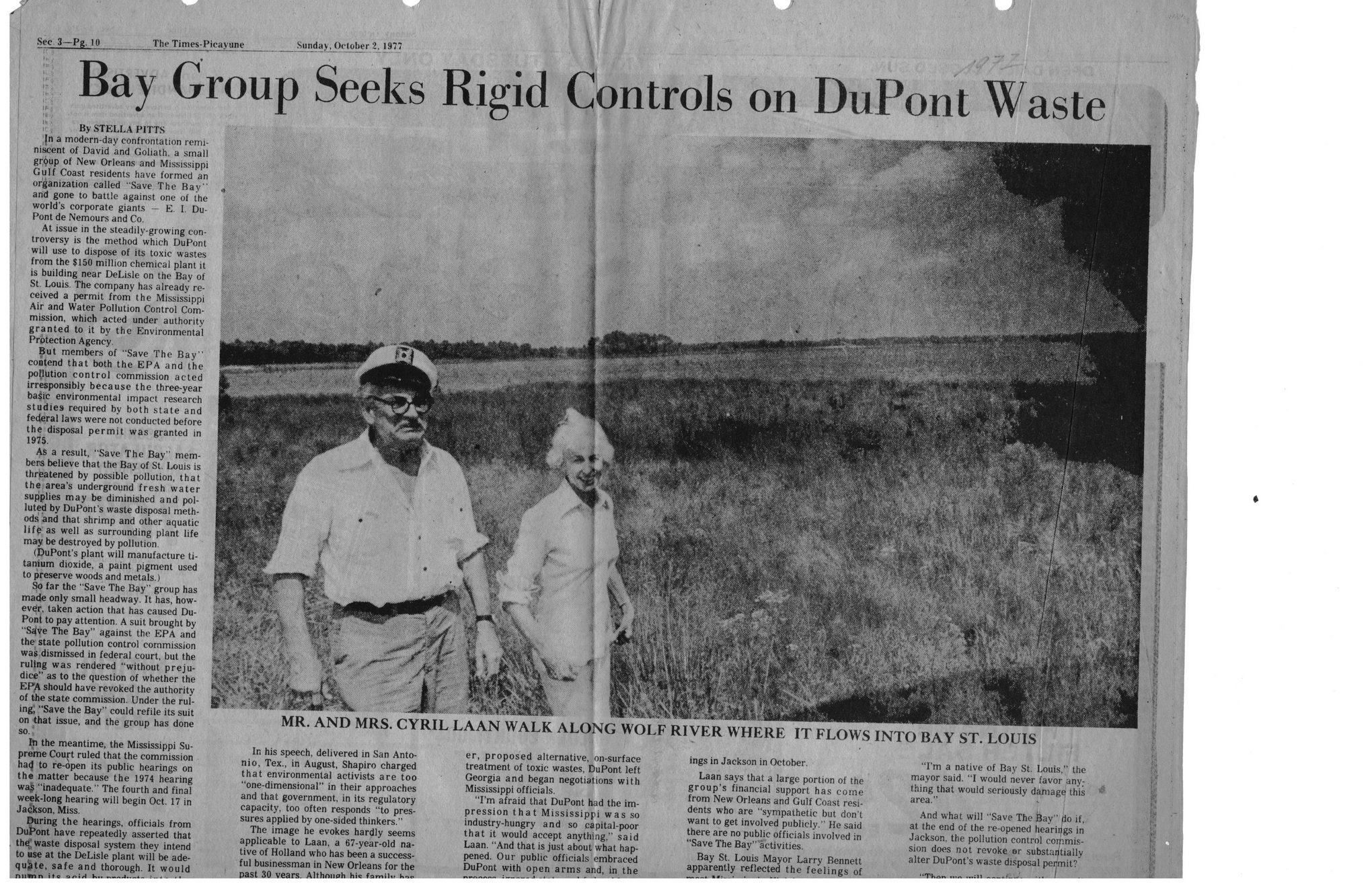This text was obtained via automated optical character recognition.
It has not been edited and may therefore contain several errors.
V Sec 3—Pg. 10 The Times-Picavune Bay Group Seeks Rigid Controls on DuPont Waste By STELLA PITTS Jn a modern-day confrontation reminiscent of David and Goliath, a small gr.Qup of New Orleans and Mississippi Gulf Coast residents have formed an organization called "Save The Bay" and gone to battle against one of the world's corporate giants ~ E I. DuPont de Nemours and Co. At issue in the steadily-growing controversy is the method which DuPont will use to dispose of its toxic wastes from the $150 million chemical plant it is building near DeLisle on the Bay of St. Louis. The company has already received a permit from the Mississippi Air and Water Pollution Control Commission, which acted under authority granted to it by the Environmental Protection Agency But members of "Save The Bay" contend that both the EPA and the pollution control commission acted irresponsibly because the three-year basic environmental impact research studies required by both state and federal laws were not conducted before the disposal permit was granted in 1975. As a result, “Save The Bay” members believe that the Bay of St. Louis is threatened by possible pollution, that the area’s underground fresh water supplies may be diminished and polluted by DuPont's waste disposal methods and that shrimp and other aquatic lifp as well as surrounding plant life may be destroyed by pollution. (DuPont’s plant will manufacture titanium dioxide, a paint pigment used to preserve woods and metals.) So far the “Save The Bay" group has made only small headway. It has, however, taken action that has caused DuPont to pay attention. A suit brought by “Stfve The Bay” against the EPA and the state pollution control commission was dismissed in federal court, but the ruling was rendered “without prejudice” as to the question of whether the EPA should have revoked the authority of the state commission. Under the ruling, “Save the Bay” could refile its suit on that issue, and the group has done so. In the meantime, the Mississippi Supreme Cou^t ruled that the commission ha<J to re-open its public hearings on the matter because the 1974 hearing wa£ “inadequate." The fourth and final week-long hearing will begin Oct. 17 in Jackson, Miss. During the hearings, officials from DuPont have repeatedly asserted that the] waste disposal system they intend to use at the DeLisle plant will be adequate, safe and thorough. It would MR. AND MRS. CYRIL LAAN WALK ALONG WOLF RIVER WHERE IT FLOWS INTO BAY ST. LOUIS Ir. his speech, delivered in San Antonio, Tex., in August, Shapiro charged that environmental activists are too “one-dimensional" in their approaches and that government, in its regulatory capacity, too often responds “to pressures applied by one-sided thinkers.” The image he evokes hardly seems applicable to Laan, a 67-year-old native of Holland who has been a successful businessman in New Orleans for the er, proposed alternative, on-surface treatment of toxic wastes, DuPont left Georgia and began negotiations with Mississippi officials. “I’m afraid that DuPont had the impression that Mississippi was so industry-hungry and so capital-poor that it would accept anything," said Laan. “And that is just about what happened. Our public officials embraced DuPont with open arms and, in the ings in Jackson in October. Laan says that a large portion of the group’s financial support has come from New Orleans and Gulf Coast residents who are “sympathetic but don’t want to get involved publicly." He said there are no public officials involved in “Save The Bay” activities. Bay St. Louis Mayor Larry Bennett apparently reflected the feelings of “I’m a native of Bay St. Louis,” the mayor said. “I would never favor anything that would seriously damage this And what will “Save The Bay’’ do if, at the end of the re-opened hearings in Jackson, the pollution control commission does not revoke or substantially alter DuPont’s waste disposal peinit?

Delisle Document-(03)